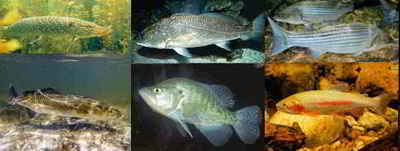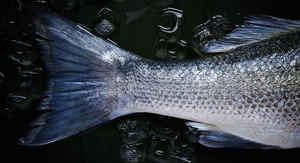
West Virginia Symbols
West Virginia State Fish
Brook Trout
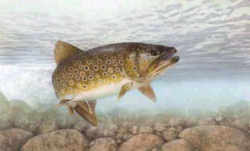
(Salvelinus fontinalis)
Adopted on March 23, 1973 .
The brook trout, (Salvelinus fontinalis,) was named West Virginia's state fish, following a poll of sportsmen which favored the fish in 1973.
As a result of this survey, the Department of Natural Resources declared the brook trout the state fish of West Virginia. And, in 1973, Delegate
Jackie Withrow of Raleigh introduced House Concurrent Resolution No. 6 proposing official recognition of the brook trout as the state fish and the
black bear as the state animal.
On February 27, 1973, the West Virginia House of Delegates voted in favor of House Concurrent Resolution No. 6 and passed it on to the Senate for their
consideration.
On March 23, 1973, the Senate also voted in favor of the brook trout as a fitting representative of the state and brook trout, (Salvelinus
fontinalis) became the official fish and the black bear became the official animal of the State of West Virginia.
A West Virginia native fish, is perhaps the most-sought-after trout by anglers, as it puts up an excellent fight for its size. It thrives in small, cold, spring-fed streams and is unable to withstand warmer temperatures. The brook trout is easy to catch and when a stream is made easily accessible by new roads, or other development, their numbers can be reduced by fishing, or eliminated by accompanying habitat changes. Because of their small size and tendency to be found in small, overgrown streams, brook trout seldom get to put up much of a fight when hooked.
The Brook Trout takes first place for the most popular state fish with these states claiming it for their Official State Fish; Maine, Michigan, New Hampshire, New Jersey, New York, Pennsylvania, Vermont, Virginia, and West Virginia. Taken as a whole, trout dominate the Official State Fish category with 18 states calling some type of trout their Official State Fish.
West Virginia State Fish: Brook Trout
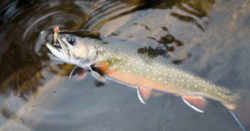
The brook trout (Salvelinus fontinalis) is a species of freshwater fish in the salmon family Salmonidae. It is native to Eastern North America in the United States and Canada, but has also been artificially introduced elsewhere in North America and to other continents. In parts of its range, it is also known as the eastern brook trout, speckled trout, brook charr, squaretail, or mud trout, among others. A potamodromous population in Lake Superior is known as coaster trout or, simply, as coasters.
Characteristics of the Brook Trout
The average length is 10-12 inches but Brook Trout can be caught measuring up to 21 inches and weighing 4-6 pounds. The largest Brook trout on record was 14.5 pounds and caught in 1916 in the Nipigon River in Ontario. Breeding males develop a hook at the front of the lower jaw. Typical coloring is olive-green to dark brown on the back with silvery sides and pale spotting. All colors intensify at spawning time.
Distribution
The brook trout is native to northern North America and is widely distributed throughout the maritime provinces. It occurs in clear, cool, well-oxygenated streams and lakes.
Foods
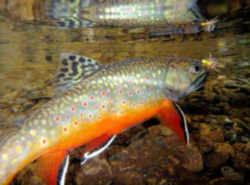
Brook trout are opportunistic feeders and will eat whatever they can find. In small streams they prefer aquatic insects (nymphs) that live under the rocks and along the stream bottom. They are also known to feed heavily on the adult stage of aquatic insects as they hatch and take flight during their brief courtship and egg laying cycle. Land insects, like ants and beetles, that fall into the water are readily eaten as are small crayfish. They will eat other small fish and minnows but only when they are easy to catch.
Biology
This species spawns in late summer or autumn in gravel beds in the shallows of headwaters of streams. The female digs the redd where she lays 100-5000 eggs depending on her size. They hatch 50-100 days later. The life expectancy is an average of five years. The brook trout is carnivorous and feed upon a wide range of organisms. They have been known to eat their own eggs at spawning time and even their own young.
West Virginia Law
The brook trout was adopted by House Concurrent Resolution No. 6. Because it was adopted by Concurrent Resolution, the brook trout is not listed in the West Virginia Code.
Taxonomic Hierarchy: Eastern Brook Trout
Kingdom: Animalia - animals
Phylum: Chordata - chordates
Subphylum: Vertebrata
Superclass: Osteichthyes - bony fishes
Class: Actinopterygii - ray-finned and spiny rayed fishes
Order: Salmoniformes - salmon and trout
Family: Salmonidae - salmon and trout
Genus: Salvelinus --
Species: Salvelinus fontinalis
